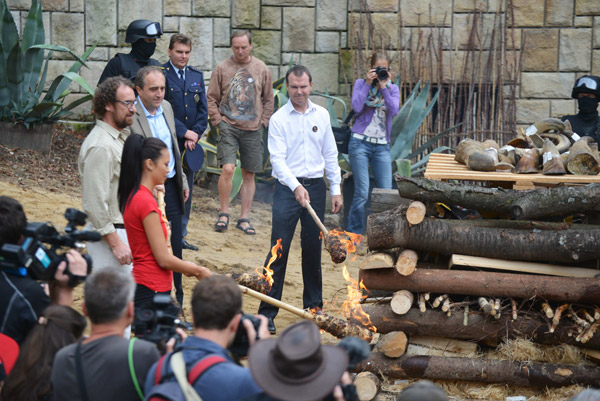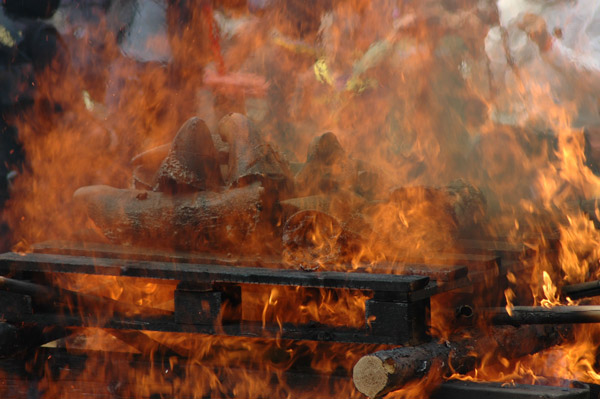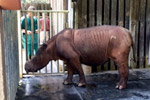
Armed customs guards stand behind a rhino horn waiting to be burnt. Photo courtesy of CITES Secretariat.
Late last month, armed guards escorted officials marching 60 kilograms (132 pounds) of rhino horns to a pyre for burning. The event, at the Dvůr Králové Zoo in the Czech Republic, was the first public burning of rhino horns in Europe.
The Czech Republic burned the horns, which came from a government stockpile as well as from past rhinos held at the zoo, in a bid to help conserve rhinos, which have been decimated by a worsening poaching crisis. In fact, the Czech Republic is often used as a transit point for smugglers of rhino horn. In 2013, officials seized two dozen white rhino horns and arrested 16 individuals for allegedly smuggling horns.
“It is necessary to show clearly that the situation of rhinos in the wild is critical and that it is the demand for rhino horn that drives them towards extinction,” said Premysl Rabas, the director of the Dvůr Královée Zoo. “Burning itself is a symbolic event that calls on everyone to re-cosider consequences of her/his behaviour. By buying rhino horn you fund criminal gangs and poachers. As a consequence of smuggling and trading in rhino horn, the rangers are killed, inhabitants of poor African regions are terrorized and beautiful animals are destined to suffer cruel death.”
This year, around 700 rhino have been slaughtered by poachers for their horns in South Africa, which is the epicenter of rhino poaching given its comparatively large rhino population. Last year, the country lost 1,004 rhino to poachers.
Rhino horn is in high demand in countries like Vietnam and China where it is consumed as a curative, despite any scientific evidence for curing properties.
“Its consistency is similar to consistency of human nails or hair,” said Rabas, pointing to the fact that rhino horn is largely composed of keratin like nails and hair.
John Scanlon, the Secretary-General with the Convention on International Trade in Endangered Species of Wild Fauna and Flora (CITES), said at the event that the burning “sends a powerful public message that the Czech Republic does not accept and will not tolerate this illegal trade or the devastating impact it is having on the rhino and on the livelihoods of local communities.”
The issue is taking on a wider public profile as well. Yesterday, thousands marched around the world in the a Global March for Elephants and Rhinos calling on governments for greater action to save these mega-fauna.

Customs guards escort the horns for burning. Photo courtesy of CITES Secretariat.

Lighting the fire to burn the rhino horns. Photo courtesy of CITES Secretariat.

Rhino horn pyre burning. Photo courtesy of CITES Secretariat.

Rhino horn’s burning. Photo courtesy of CITES Secretariat.
Related articles
558 dead: rhino poaching in South Africa on track to exceed last year’s record
(07/14/2014) Poachers have butchered 558 rhinos in South Africa so far this year, approximately a hundred more animals than lost during the same time in 2013.
U.S should sanction Mozambique for its role in elephant, rhino poaching, urges NGOs
(07/03/2014) Two prominent NGOs U.S should sanction Mozambique for its role in elephant, rhino poaching, urges NGOsare petitioning the U.S government to slap Mozambique with trade sanctions due to the country’s role in regional poaching. The groups contend that Mozambique has done little to combat both its own poaching epidemic or stop its nationals from spilling over the border to kill rhinos and elephants in South Africa and Tanzania.
On the brink of extinction: Javan rhino has new enemy in invasive palm

(07/01/2014) The last of Indonesia’s critically endangered Javan rhinoceroses have survived poachers, rapid deforestation and life in the shadow of one of the archipelago’s most active volcanoes. But an invasive plant is now posing a new threat to the world’s rarest species of rhino.
Despite poaching, Indian rhino population jumps by 27 percent in eight years
(06/10/2014) The world’s stronghold for Indian rhinos—the state of Assam—has seen its population leap by 27 percent since 2006, despite a worsening epidemic of poaching that has also seen 156 rhinos killed during the same period. According to a new white paper, the population of Indian rhinos in Assam hit 2,544 this year.
Riddled with tumors: another blow to the Sumatran rhino species

(04/14/2014) Conservation for Sumatran rhinos suffered another blow last week, only days after Suci—one of only ten rhinos in captive breeding efforts—died at Cincinnati Zoo. Scientists in the Malaysian state of Sabah revealed that a newly captured female, Iman, suffers from an assortment of tumors in her uterus, hugely complicating reproduction efforts.
Death of young Sumatran rhino shouldn’t discourage captive breeding efforts say conservationists

(04/01/2014) Just over two weeks ago, conservationists in the Malaysian state of Sabah managed to finally catch a wild Sumatran rhino female after months of failed attempts. But following such hopeful events, comes bad news thousands of miles away: a young female rhino, named Suci, died over the weekend at the Cincinnati Zoo.
Meet Iman: the Sumatran rhino’s newest hope for survival

(03/24/2014) Hopes for one of the world’s most imperiled megafauna rose this month when wildlife conservationists succeeded in catching a female Sumatran rhino named Iman in the Malaysian state of Sabah. The female, which experts believe to be fertile, has since been successfully transferred via helicopter to the Borneo Rhino Sanctuary where experts plan to mate her with the local male, Tam. Located in Tabin Wildlife Reserve, the Borneo Rhino Sanctuary is an uncompleted semi-wild enclosure and home to one of several last-ditch efforts to save the vanishing species from extinction.
Howard G. Buffett puts $24M toward saving rhinos
(03/21/2014) Howard G. Buffett, the son of Berkshire Hathaway chairman Warren Buffett, has pledged $23.7 million to South African National Parks to help fight rhino poaching in Kruger National Park, reports Reuters.